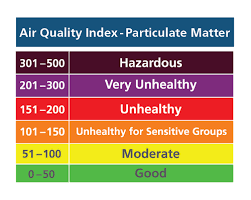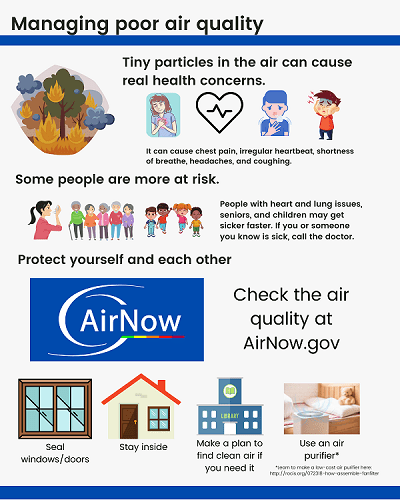About Poor Air Quality

Poor air quality is increasingly considered one of the biggest challenges facing California. Recent years of long and devastating fire seasons have contributed to poor air quality in California and impacted people all the way to the east coast. Various factors contribute to poor air quality: fire season, vehicle exhaust, industrial emissions, power plants, agricultural processes, commercial waste treatment, and any burning of fuels such as wood, oil, and coal.
The primary pollutants that contribute to poor air quality in the U.S. are ozone and particulate matter:
- Ozone: Ozone can be good or bad. Ozone is good when it is high up in our atmosphere. It protects us from sunburn. Ozone is hazardous to our health when it is near the ground where we can breathe it in.
- Particulate Matter: Particulate matter is mostly dust and soot so small that it floats in the air. Soot comes from anybody burning anything. Particulate matter also negatively impacts health, especially for those with pre-existing conditions, children, and the elderly.
The Federal Environmental Protection Agency and the California Environmental Protection Agency measure pollution in the air. Then they use the Air Quality Index, or AQI, to indicate community air quality. The AQI uses colors, numbers, and words to tell you about the quality of the air. Generally speaking, an AQI of 100 and above is considered “unhealthy” for sensitive groups, and an AQI of 150 and above is “unhealthy” for all people.
Impact on Frontline Communities
Breathing in ground-level ozone and particulate matter can reduce oxygen and make it difficult to breathe, and contribute to long-term health effects like asthma. Poor air quality disproportionately impacts people with respiratory illnesses, people who work outside all day, and children whose lungs are not fully developed. People of color and people with low incomes disproportionately suffer from respiratory illnesses. They also tend to live in communities with a higher concentration of industry, utilities, and traffic congestion. Frontline communities may also live in homes that aren’t properly sealed, don’t have access to air purifiers, and often cannot afford to stay inside on poor air quality days due to work that exposes them to the poor air quality.
Actions
For individuals
- Weatherize your home. Try to replace or seal leaky windows and doors to ensure indoor air quality is good. California has a Weatherization Assistance Program for low-income households. To be eligible, you must be a resident of California with an annual household income (before taxes) below 60 percent of the State Median Income.
- Check the Air Quality Index. There are many sources for this information. AirNow.gov is a great, reliable source where you can type in your zip code and receive the AQI as a simple, easy-to-read graphic.
- If the air is unhealthy, plan to stay inside and avoid any behaviors that worsen the situation. Set your air conditioning system to re-circulate, don’t burn candles, vacuum, and use gas or wood-burning stoves.
- If you must go outside, be prepared to be swift and use a mask only if it’s right for you. For some people, masks might make breathing even harder. If you choose to use a mask, remember that only N95 masks effectively block the particulate matter that makes air hazardous.
- Learn to recognize the signs that you or someone you know needs medical attention. Coughing, difficulty breathing, and itchy eyes are typical signs.
- Plan to seek clean air if you need it. Libraries, malls, and big commercial centers usually have clean, filtered air.
- The California Air Resources Board has a lot of great information on being ready for smoke, including how to make your own low-cost air filter.
For community-based organizations and affordable housing providers
-

- Create an Air Quality Response Protocol for what you will do when the air quality is unhealthy. For example, checking on community members, offering supplies or clean air spaces, and telling people to stay home if possible.
- Investigate the California Low Income Weatherization Program – for Multifamily Properties. Weatherization can help your building be more energy efficient through sealing, which will also help protect residents against poor air quality.
- Support farmworkers and outdoor workers in knowing their rights to clean air. The California Occupational Safety and Health Agency has a resource for worker safety in wildfire regions in Spanish and English.
- Follow public comment opportunities from the California Air Resource Board and your local Air Quality Management District. These organizations make plans and rules for air quality in California. They also usually have funding opportunities that you might consider and/or promote with others.
For local and state government
- Add poor air quality prevention to your Hazard Mitigation Plan. Create and or develop a response protocol for poor air quality days in partnership with frontline communities.
- Create clean air centers in frontline communities. Use spaces that are already common gathering spots.
- Create a free air purifier program to distribute air purifiers to frontline communities, like this program in the City of Ashland.
- Work with community-based organizations to ensure proper training and education on being prepared for poor air quality and how to use a mask. Ensure that outreach is done in a culturally competent and humble way and in each participant's native language. Read about Emergency Operations Plans and cultural competence.
- Create model laws to protect frontline communities from poor air quality. For example, The Farmworker Smoke Protection Act of 2019, which requires the Occupational Safety and Health Administration (OSHA) to address the exposure of farmworkers to wildfire smoke. OSHA will now require employers to offer protective equipment and offer training on how to use it. This is a good start. However, we need enforcement mechanisms to make sure workers are safe and have ways to take time off if they shouldn’t be outside.
- Divest from the fossil fuel industry, which causes poor air quality that disproportionately impacts frontline communities.
For philanthropy
- Support funding for air filters and purifiers, masks, and the weatherization of homes and apartments for frontline communities. There are many grassroots organizations and mutual aid networks that can fund deliver these resources on the ground.
- Support organizations whose advocacy work is aimed at reducing carbon emissions and building healthier communities. These organizations advocate for public transportation, bicycle and pedestrian infrastructure, and neighborhood greening projects like tree planting, all of which improve air quality. Divest from fossil fuels which disproportionately impact frontline communities and make the air quality poor.
- Vehicle and building electrification can improve indoor and outdoor air quality while also reducing global carbon emissions. However, the source of electricity must be clean so that the increased burden of electricity generation does not fall on frontline communities, who are disproportionately located in poor air quality areas near power plants.
- Divest from the fossil fuel industry, which causes poor air quality that disproportionately impacts frontline communities.
- Training